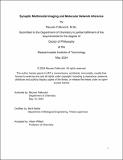Synaptic Multimodal Imaging and Molecular Network Inference
Author(s)
Falkovich, Reuven
DownloadThesis PDF (9.720Mb)
Advisor
Bathe, Mark
Terms of use
Metadata
Show full item recordAbstract
All cognitive function is reliant on synaptic function – the molecular computation that integrates activity history, chemical environment, and the genetic state of its pre- and post-synaptic neurons to modulate neuron-neuron communication through synaptic plasticity. This computation is performed by the highly compartmentalized, tightly regulated, and complex network of interactions between synaptic activity and hundreds of proteins and the mechanisms that regulate them. Isolating individual processes loses the context in which they occur, while bulk analyses average over highly heterogeneous populations and lose correlation information. A top-down study of the entire system in action requires measurement of multiple synaptic parameters – composition and activity - simultaneously in individual synapses. Building on a previously developed probe exchange multiprotein imaging technique, this thesis presents MINI-ME, a versatile, modular platform for integrating multiple information modalities at single synapses. We developed an approach for tandem live-fixed imaging to combine synaptic calcium dynamics or glutamate spiking information with multiprotein measurements. We also developed an integration of rolling circle amplification-based in situ methods, such as a reporter on gene specific translation. We analyzed, based on simulated and experimental data, the application of Bayesian network inference to analyze high-dimensional multimodal synapse distributions to extract biological insight. Finally, we applied this new approach to in-depth investigation of synaptic molecular perturbations associated with autism and schizophrenia genetics and psychiatric drug activity
Date issued
2024-05Department
Massachusetts Institute of Technology. Department of ChemistryPublisher
Massachusetts Institute of Technology